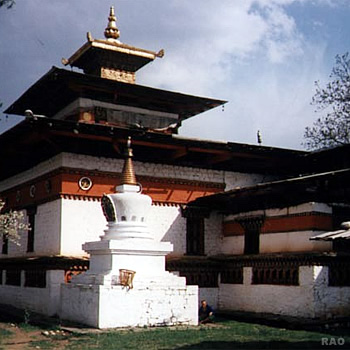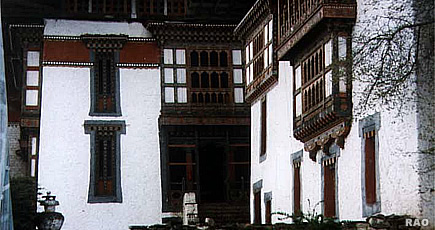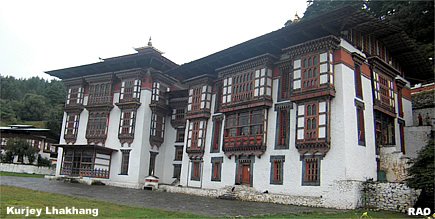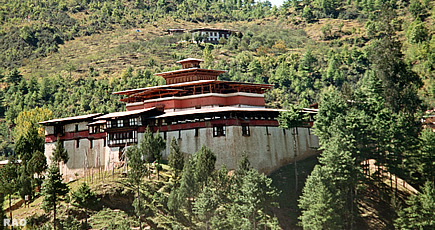 |
Bhutan Architecture |
|
 |
Bhutan Information |
|
 |
Different
types of buildings |
|
 |
Different
types of buildings |
|
|
|
Bhutanese
architecture is famous for its originality, its harmonious proportions
and its adaptation to the landscape.
 |
Kyichu Monastery near Paro
The first recorded buildings
in Bhutanese history were the temples of Lhakhang Karpo and Nagpo in Haa,
Kyichu near Paro and Jampa, Koebnchog-sum and Gayney Lhakhangs in Bumthang,
built around the 6th and the 7th centuries. From the 11th century until
the early 17th century, numerous lamas and their disciples built temples
and monasteries all over the country. From the buildings dating back to
the 17th century that still exist, it can be seen that they were relatively
small structures with a courtyard enclosed within their walls. In most
cases they were only one-storied built close to the temples were the lama's
residence with the quarters for his disciples. Among the most active temple-builders
in the 15th century were Ngawang Choegyal, the great grandfather of Zhabdrung
Ngawang Namgyal, and Tertoen Pema Lingpa.
|
Fortresses
such as Jathel Dzong, Chelkha Dzong and Dongoen Dzong were built by the
Lhapa Kagyu religious school which once dominated the western
region in the 12th century. In the eastern region, stone castles called
khar were built mostly by the local nobility.
In the early 15th century,
the saint Drubthop Thangthong Gyalpo, who was popularly known as Chagzampa,
visited the country and built iron bridges in different parts of Bhutan.
The
architectural landscape changed in the 17th century when Zhabdrung Ngawang
Namgyal introduced the construction of dzongs which became the model for
all monasteries built or restored from that time. Gangtey Goemba, Dramitse
and Tango monasteries are based on the dzong model.
After Zhabdrung Ngawang
Namgyal, one of the most active temple builders was the 4th Desi, Tenzin
Rabgye, who at the end of the 17th century had Taktshang and Tango built
in their present form.
From the second half of the 19th century and especially
after the earthquake of 1905, temples and dzongs were restored and palaces
were built. The active patrons were Jigme Namgyal and the successive Kings
and their Queens. Some of the best examples of Royal patronage are the
Kharbandi monastery in Phuenbtsholing, the Memorial Chorten in Thimphu,
the new Kyechu Lhakhang in Paro and the newly built Kuje Lhakhang in Bumthang.
top
|
Special
characteristics of Bhutanese architecture |
 |
House in Bumthang The
eleven-day annual In Bhutanese architecture, there is generally no planning
and designing done on paper before a structure is built. The chief carpenter
is the master of work and he has the size, layout and structure in his
mind. He uses parts of his body for measurement and proportions of the
different features of the building. He supervises other carpenters, stone-cutters
and village workers. No nails are used and the wood pieces are assembled
by the dovetail technique.
|
The
many examples of traditional Bhutanese architecture that we see were all
built in this way. Architectural styles differ from place to place and
from different periods in time.
The
differences in style are due to:
-
availability of building materials;
-
physical and climatic conditions;
-
social and economic development;
-
religious and cultural traditions.
The
main materials used have been stones, compressed earth (mud), wood and
bamboo. Stone or rock is mostly used for dzongs and religious buildings
while village houses are made of stones and compressed earth. Wooden shingles
are commonly used for roofing. In some parts of eastern Bhutan bamboo mats
are also used for roofing. Wood is used especially for windows, balconies
of dzong buildings and temples. Windows have a distinctive trefoil shape
and elaborate lintels painted with geometrical and floral motifs.
The
characteristics of Bhutanese architecture are generally:
-
lavish use of wood;
-
sloped whitewashed walls;
-
window size increasing with the stories;
-
the trefoil shaped windows;
-
the pitched roof covered with shingles and weighed down with stones.
Once
the building is completed, artists often embellish it by painting different
auspicious motifs. The selection of the site for any building, as well
as the different steps of the construction, are guided by the astrologer's
calculations and always followed by rituals. For religious buildings, the
configuration of the site and good omens are considered very important.
top
|
Different
types of buildings |
|
Lhakhang
(Temples) |
 |
Kurjey Lhakhang near Jakar, Bumthang
Temples
are usually one or two-storied buildings with a wide red stripe at the
upper level of the walls and a gilded roof ornament. A small courtyard
may be enclosed in the walls with the residence of the lame attached to
it.Inside, the ceiling is supported by pillars, which divide the space
into a shrine and an antechamber, and the walls are covered with paintings.
The altar occupies one side of the shrine with the other side usually devoted
to protective deities. |
The rest of the space is left empty to be used by
devotees for performance of rituals. Many temples are also housed
in monasteries and dzongs.
top
|
Goemba
/ Gompa (Monasteries) |
The
monasteries are of two types:
 |
| Simthoka
Dzong near Thimphu |
|
 |
The
cluster type is probably more ancient. It consists of one or two temples
housed in a building and surrounded by small houses, which serve as living
or meditation quarters for the monks. Some examples of the cluster type
are Dzongdrakha in the Paro valley, Dodedra, Phajoding, Chari and Trashigang
nunnery in the Thimphu region, Kuenzangdra and Tharpaling in the Bumthang
region as well as most of the monasteries in the eastern region. |
|
 |
The
dzong type is a monastery built like a fortress with a main tower, housing
many temples and a surrounding outer structure which provides accommodation
for the monks.
The most impressive examples of this type are Tango in the
upper Thimphu valley, Talo in Punakha, Gangtey Goemba near Pelela and Dramitse
in eastern Bhutan. |
| Information on Bhutan |
 |
|





